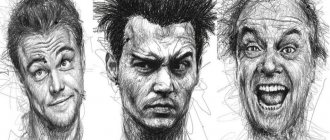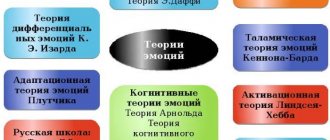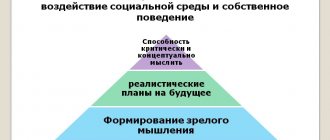Various classifications of human emotional states
One of the most important issues in psychological science is the issue of classification of human emotional processes.
Due to the fact that emotions are systemic phenomena and, in accordance with this, have systemic qualities, it is the identification of these qualities that contributes to the formation of various classifications of human emotional states. Note 1
However, drawing up a universal classification of emotional states is not possible due to the fact that human emotions can be viewed from different angles and grounds. Let's consider the most popular classifications of human emotions.
Classification of emotional states by Dodonov B.I.
The main object of attention is the classification of emotional states according to B.I. Dodonov. Not all emotional states of a person are, but only those of them for the functioning of which a person has the greatest need and which add value to the implementation of the process. Thus, we can say that Dodonov’s classification highlights those human emotions that are valuable experiences for him.
Finished works on a similar topic
- Course work Classification of emotional processes 470 rub.
- Abstract Classification of emotional processes 260 rub.
- Test work Classification of emotional processes 250 rub.
Receive completed work or specialist advice on your educational project Find out the cost
So, to the emotional states of a person, B.I. Dodonov. refers:
- Altruistic emotions, which include a person’s experiences that arise on the basis of his existing needs for help, patronage, and assistance to people around him. These experiences arise based on the need for assistance, help, and patronage of other people.
- Communicative emotions that arise when a person has a need to communicate with other people.
- Gloric emotions associated with a person’s need for self-affirmation and glory.
- Praxic emotions are experiences that are caused by human activity, its changes, the success or failure of its results.
- Frightening emotions that arise as a result of a person’s need to overcome emerging danger and, as a result, form an interest in the fight against surrounding difficulties and obstacles.
- Romantic emotions, manifested in a person’s desire for everything extraordinary, unusual and mysterious.
- Gnostic emotions, which the author associated not only with a person’s need to receive new information from areas of interest to him, but also with a person’s need for so-called “cognitive harmony.” The essence of cognitive harmony is to highlight elements of already familiar knowledge in any new and unfamiliar information, thus bringing all information to one “common denominator.”
- Hedonic emotions associated with the process of satisfying a person’s need for bodily and mental comfort.
- Active emotions that arise in connection with a person’s interest in accumulating certain things, while this interest goes beyond the practical need for these things.
Too lazy to read?
Ask a question to the experts and get an answer within 15 minutes!
Ask a Question
Psychology of emotions.
Emotional processes, in a broad sense, usually include affects, emotions themselves, feelings and other forms of these processes.
With a narrow understanding of emotions, they are considered as a reaction to such specific conditions as success, the impossibility of adequate behavior, a conflict situation, and unforeseen developments of events. Emotions in the narrow sense have a clearly expressed situational character.
We can state a double conditionality of emotions: on the one hand, by needs (motivation), personal characteristics, and on the other, by the characteristics of influences (situation).
Emotions are manifested:
a) in internal experiences,
b) in behavior,
c) at the physiological level. The Yorks-Dodson Law states the presence of a curvilinear, “bell-shaped” relationship between the strength of emotional arousal and the success of human activity. The most productive activity occurs at a moderate, optimal level of arousal.
Functions of emotions:
1. Control or evaluation, if the activity is successful, then positive emotions arise, if failure - negative. All behaviors that evoke positive emotions are reinforced;
2. Guiding, motivating and protecting;
3. Communicative, expressive;
4. Connection between the psyche and the body, activation and mobilization-demobilization;
5. Reflections.
Emotional characteristics and personality traits.
Emotional characteristics include: emotional excitability, emotional impulsivity and affectivity, emotional stability, strength, pace and rhythm of emotional reactions, emotional tone.
The emotional characteristics of a person together form the emotional-affective sphere, in which the dynamic side of emotional processes is expressed.
4 pp., 1528 words
Formation of an emotionally positive attitude towards the environment in children with intellectual disabilities
CONTENTS INTRODUCTION 4 CHAPTER I. PSYCHOLOGICAL - PEDAGOGICAL ASPECTS OF THE PROBLEM OF FORMING AN EMOTIONAL ATTITUDE TO THE ENVIRONMENT IN PRESCHOOL CHILDREN WITH INTELLECTUAL DISABILITIES 7 1.1. Historical and theoretical aspects of the problem of emotional attitude towards the environment in preschool children 7 1.1.1. Study of emotional relationships: characteristic problems and difficulties 7 1.1.2. Studying …
This dynamic side of emotional processes manifests itself in involuntary expressive movements: facial expressions, pantomime, gestures, intonation and expressive means of speech. Emotional personality traits: impressionability, responsiveness, etc.
5
.Theories of emotions.
1) Evolutionary theory of Charles Darwin:
a) there is a connection between the common anatomical and physiological organization of living beings and the external expression of their emotional experiences,
b) emotional expressions are remnants of once existing full-fledged, adaptive, useful actions,
c) external emotional expression is innate and performs an adaptive biological function.
2) James-Lange theory:
The root causes of emotional states are physiological changes in the body. First, organic changes occur in response to external or internal stimuli, and then, as a result of their subjective reflection, emotions arise. Objections: a) bodily reactions to different emotions are very similar and unsatisfactorily explain the qualitative diversity of human emotions, b) organic changes artificially induced in a person (which are usually associated with an emotional state) are either not accompanied by emotional experiences, or are subjectively perceived differently than those appearing in natural conditions.
3)W. Cannon's theory
: emotional experiences and the corresponding organic changes are generated simultaneously and arise from a single brain center - the thalamus.
4) The theory of cognitive dissonance by L. Festinger
: positive emotions arise as a result of confirmation (consonance) of expectations, negative emotions arise as a result of dissonance between expectations and performance results. Exiting the state of cognitive dissonance: a) changing expectations, b) trying to get a new result.
5) Cognitive-physiological theory of S. Schechter
. The emotional state is influenced by:
3 pages, 1141 words
Club paradoxical theory of change
Paradoxical Theory of Change by Arnold Beisser Translation by A. Gronsky Arnold Beisser's article is one of the most frequently cited in Gestalt literature. The original text can be read on the website of the International Gestalt Therapy Association (IGTA) For approximately half a century, i.e. For most of his professional life, Frederick Perls was in conflict with psychiatric and...
a) perceived stimuli, b) bodily changes caused by these stimuli, c) past experience, d) a person’s assessment of the current situation from the point of view of his current interests and needs.
The nature and intensity of a person’s emotional experiences depend on how others around them experience the same situation.
6) Information theory of P. V. Simonov:
the strength and quality of emotions is determined by the strength of the need and the assessment of the ability to satisfy it in the current situation.
Classification of human emotional states according to V. K. Vilyunas
V. K. Viliunas distinguishes two groups of emotional phenomena:
- The author includes the leading emotional phenomena in the first group, which are a stimulus and encourage a person to carry out activities. Also, this group of emotions is responsible for the general direction of human activity. They largely determine the direction of emotional life.
- The second group includes derivative emotional phenomena that arise under an already existing leading impulse, in the process of a person performing a particular activity and expressing a certain attitude of a person to certain conditions for the implementation of actions, which are either favorable or impede its implementation.
Classification of emotions according to subjective experience and content.
The most famous is the division of human emotional states according to their subjective experience. According to this classification, there are two categories of emotions:
- Positive emotions that are associated with a person’s satisfaction of his life needs and, in connection with this, giving him a feeling of satisfaction.
- Negative emotions associated, respectively, with the processes of dissatisfaction of a person’s needs and causing him displeasure.
According to the classification of emotions according to their content, simple and complex emotions are distinguished. Simple emotional states include anger, fear, joy, envy, and jealousy. Complex emotions include moral feelings and aesthetic feelings of a person.
Emotional processes and states
Lecture: “Emotional processes and states.”
In the process of evolution of the animal world, a special form of manifestation of the reflective function of the brain appeared - emotions (I excite, excite - lat.).
Emotional processes are mental processes that occur in the form of experiences and reflect personal significance and assessment of external and internal situations for a person’s life. Emotions are a mental reflection of the vital meaning of phenomena and situations, manifesting themselves in the form of immediate “momentary” biased experience, conditioned by the relationship of their objective properties to the needs of the subject.
Types of emotional processes.
1.Affect
.
2.Emotions
.
3.Feelings
– more stable mental states, have a clearly defined character, cannot be irrelevant. Depending on the direction:
A. moral – attitudes towards other people;
b. intellectual – associated with cognitive activity;
V. aesthetic - feelings of beauty when perceiving nature, art;
d. practical – related to human activity.
4.Mood
- the longest lasting psychological state that colors all human behavior. It can increase or decrease a person’s vital activity.
5.Passion
- a strong, stable, all-encompassing feeling that dominates other human impulses. Leads to concentration on the subject of passion of all forces and aspirations. The main feature is effectiveness, the fusion of volitional and emotional aspirations. The combination of passion and morality in a person serves as the driving force behind great deeds, discoveries, and exploits.
6. Stress
- neuropsychic overstrain caused by an extremely strong impact, an adequate response to which has not previously been formed, but must be found in the current situation. Stress is a nonspecific response of the body to external or internal demands placed on it.
Frustration is directly related to stress.
Frustration (from Latin frustratio - deception, futile expectation) is a special emotional state that occurs when a person, faced with any obstacles, cannot achieve his goals and the satisfaction of any desire or need becomes impossible. Frustration can arise both as a result of a collision with external obstacles, and during an intrapersonal conflict.
In a state of frustration, a person experiences a full range of negative emotions: anger, despair, anxiety, irritation, disappointment, etc. A long stay in this state can lead to complete disorganization of human activity. Frequent states of frustration can influence character: increase aggressiveness, provoke the appearance of an inferiority complex
Functions of
emotions
The experience of feeling is a mental process that has its own dynamics, current and changeable.
Emotions perform the following functions: reflective-evaluative; switching; regulatory; communicative; reinforcing; compensatory (replacement); incentive; disorganizing; function of “emergency” resolution of situations; anticipating; heuristic; the function of the synthesizing basis of the image, the integrity of the reflection; function of activation and mobilization of the body; expressive.
Physiological and behavioral components of emotions
. The emergence of emotions begins with changes that occur in the external world. These changes lead to an increase or decrease in vital activity, the awakening of some needs and the extinction of others, to changes in the processes occurring inside the human body. Physiological processes characteristic of the experience of feelings are associated with both complex unconditioned and conditioned reflexes. As is known, systems of conditioned reflexes are closed and fixed in the cerebral cortex, and complex unconditioned reflexes are carried out through the subcortical nodes of the hemispheres, the visual hillocks related to the brain stem, and other centers that transmit nervous excitation from the higher parts of the brain to the autonomic nervous system. Experiences of feelings are the result of the joint activity of the cortex and subcortical centers.
The more important the changes that happen around him and with him are for a person, the deeper the feelings are. The resulting excitation processes, spreading across the cerebral cortex, capture the subcortical centers. In the parts of the brain lying below the cerebral cortex, there are various centers of physiological activity of the body: respiratory, cardiovascular, digestive, secretory, etc. Therefore, excitation of the subcortical centers causes increased activity of a number of internal organs. In this regard, the experience of feelings is accompanied by a change in the rhythm of breathing (a person chokes from excitement, breathes heavily and intermittently) and cardiac rhythm (the heart freezes or beats intensely), the blood supply to individual parts of the body changes (they turn red from shame, pale from horror), the functioning of secretory organs is disrupted. glands (tears from grief, dry mouth from excitement, “cold” sweat from fear), etc. These processes occurring in the internal organs of the body are relatively easy to register and self-observe, and because of this, from ancient times they have often been accepted as the cause of feelings. In our usage of words, the following expressions are still preserved: “the heart does not forgive”, “longing in the heart”, “to conquer the heart”, etc. In the light of modern physiology and psychology, the naivety of these views is obvious. What was taken as a cause is only a consequence of other processes occurring in the h-ka’s brain.
The cerebral cortex under normal conditions has an inhibitory effect on the subcortical centers, and thus external expressions of feelings are restrained. If the cerebral cortex comes into a state of excessive excitation when exposed to strong stimuli, overwork, or intoxication, then as a result of irradiation, the centers lying below the cortex are overexcited, as a result of which ordinary restraint disappears. And if in the subcortical nodes of the hemispheres and diencephalon, in the case of negative induction, the process of widespread inhibition spreads, depression, weakening or stiffness of muscular movements, decline in cardiovascular activity and respiration, etc. are observed. Thus, when experiencing feelings, during emotional states, both an increase and decrease in the intensity of different aspects of human life are observed.
Essentially important data for understanding the nature of emotions were also obtained from the study of functional asymmetry of the brain. In particular, it turned out that the left hemisphere is more associated with the emergence and maintenance of positive emotions, and the right hemisphere is more associated with negative emotions.
Satisfaction or dissatisfaction of needs gives rise to specific experiences in a person that take on various forms: emotions, affects, moods, stressful conditions and feelings themselves (in the narrow sense of the word).
Functions of emotions:
Emotions performing the function of evaluation
, directly in experience they evaluate and express the significance of objects and situations for achieving goals and satisfying the needs of the subject. Emotions are the language, the system of signals through which the subject learns about the significance of what is happening.
Emotions perform the function
of motivation
; from the assessment of what is happening, the motivation to action follows. Depending on the sign of the assessment (positive or negative), the action can be aimed either at appropriating, mastering the required, necessary, or at stopping an unsuccessful action, or at choosing another.
Emotions are a mental process of subjective reflection of a person’s most general attitude towards objects and phenomena of reality, towards other people and himself in relation to the satisfaction or dissatisfaction of his needs, goals and intentions.
If the process of satisfying needs proceeds favorably, then a person experiences positive emotions, and, on the contrary, negative emotions arise in response to the unsatisfaction of needs or the lack of the desired result of one’s own actions.
Emotions, like sensations, perceptions or thinking, are one of the forms of reflection of the real world by consciousness. However, emotions reflect objects and phenomena not in themselves, but in their relation to the subject, their significance for his needs and motives for activity. Thus, emotions are determined, on the one hand, by internal needs and motivation, and on the other, by the characteristics of the external situation. They seem to establish a connection and relationship between these two series of events, signaling to the subject about the possibility or impossibility of satisfying his needs under given conditions.
3








